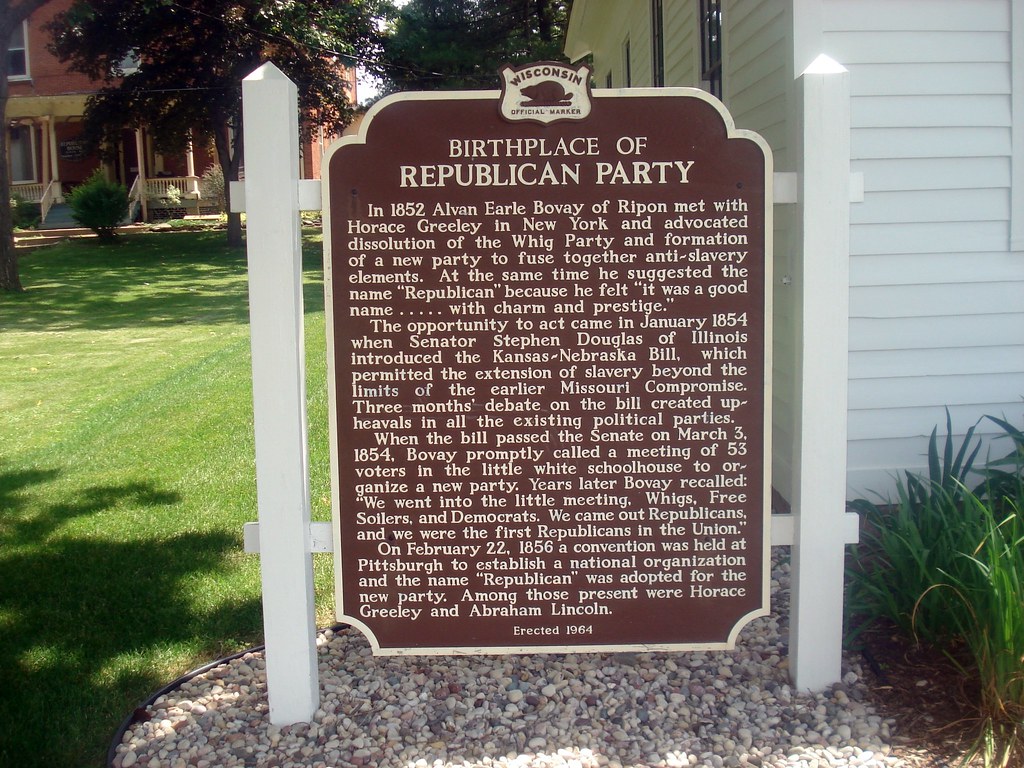Learn more about our history below

Though popularized in a Thomas Nast cartoon, the GOP’s elephant symbol originated during the 1860 campaign, as a symbol of Republican strength. Republicans envisioned “free soil, free speech, free labor.” Under the leadership of President Abraham Lincoln, the GOP became the Party of the union as well.
President Lincoln issued the Emancipation Proclamation, but it was the entire Republican Party who freed the slaves. The 1864 Republican National Convention called for the abolition of slavery, and Congressional Republicans passed the 13th Amendment unanimously, with only a few democrat votes.
The early women’s rights movement was solidly Republican, as it was a continuation of abolitionism. They were careful not to be overly partisan, but as did Susan B. Anthony, most suffragists favored the GOP. The 19th Amendment was written by a Republican senator and garnered greater support from Republicans than from Democrats.
It began in a little schoolhouse in Ripon, Wisconsin, in 1854. A small group of dedicated abolitionists gathered to fight the expansion of slavery, and they gave birth to a Party dedicated to freedom and equal opportunity.
The name “Republican” was chosen, alluding to Thomas Jefferson’s Democratic-Republican Party and conveying a commitment to the inalienable rights of life, liberty, and the pursuit of happiness.
The Party was formally organized in July 1854 by thousands of anti-slavery activists at a convention in Jackson, Michigan. And it was no accident that two years later, in 1856, the first Republican National Convention took place in Philadelphia, where the Constitution was written.


President Reagan and President George H.W. Bush led western democracies to victory over Soviet tyranny in the Cold War. The George W. Bush administration maintained the military second-to-none and projected that power in the fight against international terrorism.
Drawing inspiration from our Party’s history, today’s Republicans believe individuals, not government, make the best decisions; all people are entitled to equal rights; and decisions are best made close to home.
At the state level, the nation’s thirty Republican governors are making government more effective and efficient, spurring economic growth and striving to put more power in the hands of the people.
Nationally, Republicans recognize that the slow, bloated, top-down Washington bureaucracy is out-of-date in the 21st century. Our Party works to give Americans more choices—in healthcare, in education, in energy, and in the economy—and to free individuals and families from the intrusive overreach of federal bureaucrats.
The Party’s core principles of freedom and equal opportunity are as relevant today as at our founding, and they are the roadmap for American renewal in a new and interconnected world.
Low taxes, sound money, regulatory restraint: these were among the commonsense economic policies established by the GOP that brought about decades of prosperity after the Civil War. Republicans encouraged innovation and rule of law. Buttressed by Republican control in Congress, the McKinley, Theodore Roosevelt and Taft administrations cleared away obstacles to economic growth.
President Dwight Eisenhower and congressional Republicans appreciated the fact that the private sector, not government, is the engine of wealth creation. With his bold tax-cutting agenda, President Ronald Reagan revived the economy after years of Democrat malaise.
Theodore Roosevelt embodies our Party’s traditional concern for the environment, but the Republican commitment to the environment actually goes back much further than that. For example, the world’s first national park, Yellowstone, was established during the Ulysses Grant administration.
President Eisenhower advocated groundbreaking civil rights legislation and vigorously enforced the Brown v Board of Education decision, sending the 101st Airborne to Little Rock when chaos erupted following integration at Central High.
Ronald Reagan explained the difference between Democrats and Republicans in a way that cannot be improved upon: “Two visions of the future, two fundamentally different ways of governing – their government of pessimism, fear, and limits, or ours of hope, confidence, and growth. Their government sees people only as members of groups. Ours serves all the people of America as individuals.”
President George H.W. Bush championed community and volunteer organizations and the tremendous power they have for doing good. He famously described them as “a brilliant diversity spread like stars, like a thousand points of light in a broad and peaceful sky.”
In the first decade of the 21st century, President George W. Bush made an unprecedented commitment to helping those in need beyond our shores through the President’s Emergency Plan for AIDS Relief (PEPFAR), an aid program for countries devastated by HIV/AIDS. Since its inception, PEPFAR has saved over a million lives and currently provides over 5 million people with life-saving treatments.
March 20, 1854
First Republican Party meeting in Ripon, Wisconsin
January 1, 1863
President Abraham Lincoln issues Emancipation Proclamation
January 31, 1865
Republican-controlled 38th Congress passes the 13th Amendment abolishing slavery
June 13, 1866
With unanimous Republican support and against intense Democrat opposition, Congress passes the 14th Amendment
March 1, 1872
Republican-controlled 42nd Congress establishes Yellowstone as first national park
December 9, 1872
First African-American governor, Pinckney Pinchback (R-LA), inaugurated
March 4, 1917
First woman in Congress, Rep. Jeannette Rankin (R-MT), sworn in
June 4, 1919
Republican-controlled 66th Congress passes the 19th Amendment guaranteeing women the right to vote
June 2, 1924
Republican-controlled 68th Congress and President Calvin Coolidge grant citizenship to Native Americans with the Indian Citizenship Act
December 7, 1928
First Hispanic U.S. Senator, Senator Octaviano Larrazolo (R-NM), sworn in
January 3, 1949
Margaret Chase Smith (R-ME) becomes the first woman to serve in both the Senate and the House of Representatives.
May 17, 1954
Brown v Board of Education strikes down racial segregation in public schools; majority decision written by Chief Justice Earl Warren, former Republican governor (CA) and vice presidential nominee
August 21, 1959
first Asian-American U.S. Senator, Hiram Fong (R-HI), is seated
September 9, 1957
President Dwight Eisenhower signs the 1957 Civil Rights Act
June 10, 1964
Senate passes the 1964 Civil Rights Act when the Republican leader, Everett Dirksen (R-IL), defeats Democrat filibuster
September 25, 1981
Sandra Day O’Connor, appointed by President Reagan, becomes first woman on the Supreme Court
June 12, 1987
President Ronald Reagan calls for liberation of East Europeans from Communism with “Tear Down This Wall” speech
Paid for by the Republican Party of San Diego County |
FEC # C00252551 ● FPPC ID 741949 ● FEIN 95-1540609